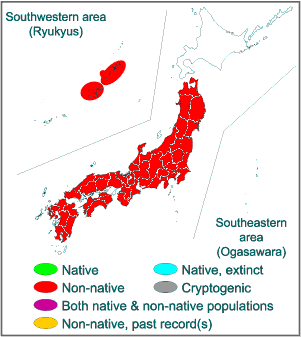| Invasion information |
| Range in Japan |
Central to Southern Japan. Hachijojima Is. (Izu Islands). Especially abundant in Kyushu and Shikoku Islands. |

|
| Origin |
USA |
| Date |
Imported to Japan around 1880-1900. Established by 1972. |
| Route |
Deliberate: as ornamental plant and cattle feed. Now distributed for ornamental, cleaning up water, plant food, etc. |
| Impact |
Competition against native species and crop (rice). Disturbance of river transport. Carrying plant pests (pest insects, mites, virus, etc.)
Native organism(s) affected: Aquatic plants, rice, etc. |
| Regulation in Japan |
Keeping of this species in Saga Pref. are controled by a prefectural ordinance. Import to Australia is prohibited. |
| Introduced range in other countries |
South Korea, Taiwan, N America, W Europe, Africa, Oceania, Hawaii |

 Japanese |
English
Japanese |
English